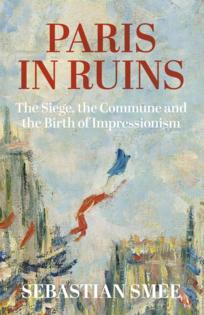Review: Love, war and the birth of many of the world's most beloved artworks in 'Paris in Ruins'
Published in Books News
Soon after the French Revolution, the Paris Salon emerged as one of the most prestigious annual art exhibitions in the western world.
Acceptance by the jury depended as much on politicking as merit, on what was permissible as what was au courant. Rejected artists could mount a solo show, which rarely flourished, or a breakaway group exhibition — one of which succeeded in spectacular fashion in 1874. That year, the likes of Degas, Monet, Renoir, Cézanne, and the lesser-known Berthe Morisot signed on to the first of eight exhibitions that established one of today’s most beloved movements: Impressionism.
The environment that cultivated the birth of modern painting is one facet of “Paris In Ruins,” the new book from Washington Post art critic Sebastian Smee. As its title suggests, the book presents the Impressionist movement as rising from the ashes, in this case out of the chaos and bloodshed that began with the onset of the Franco-Prussian War in the summer of 1870 and concluded with the internecine violence of the Paris Commune in the spring of 1871.
For large parts of the book, artists take a backseat to armies, but when the focus is painting, Smee’s story circles around the relationship between Morisot and Édouard Manet, the one prominent Impressionist who passed on 1874′s groundbreaking exhibition.
When the two meet in 1869, Morisot is establishing herself while Manet has spent the decade turning out “one arresting canvas after another, all in a distinctive style.” She poses for him several times and falls “under some kind of spell,” though the married Manet shows no more interest in her than his other models.
The start of the war and Prussia’s siege of Paris means the making of art falls by the wayside. Most of our artists leave the city, dropping out of the narrative for a stretch, but Manet and Morisot remain. He ends up doing little in the National Guard, while she continues to wrestle with her needs and desires. The political and martial maneuvering is overpowering but often fascinating, particularly the use of hot air balloons to transport mail — and military personnel — in and out of the blockaded city.
After the siege is lifted, Parisian life normalizes a bit, but the simmering tension leads even Morisot and Manet to relocate temporarily. Smee’s blow-by-blow account of the reciprocal killings during the Commune is as exhaustive as it is exhausting. Blessedly, the fighting ends, the artists return to Paris and the narrative returns to Manet and Morisot’s conversation through their art. They are now “palpably in love,” Smee writes, as is “evident to anyone looking at [his] portraits of her.”
Smee has a tremendous knack for placing readers inside historical scenes, but can be hyperbolic and repetitive. He excels at interpreting art, clearly sketching how Manet and Morisot influenced each other, though is less convincing linking the development of their art to the events of 1870-71.
“Paris In Ruins” often feels like it desperately wants to be a Morisot biography, or perhaps that was just increasingly my desire to learn more about this “poet of the ephemeral.” All art is subjective, but I would have liked the military and political particulars to be de-emphasized, less naturalistic and more impressionistic — like these memorable artists.
____
Paris in Ruins
By: Sebastian Smee.
Publisher: Norton, 384 pages, $35.
©2024 The Minnesota Star Tribune. Visit at startribune.com. Distributed by Tribune Content Agency, LLC.













Comments